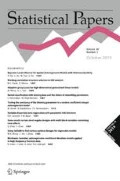Abstract
The connection between Stirling numbers of the first kind and records is well-known. Applying this relationship, we derive bounds for the maximum likelihood estimator of the sample size based on the number of observed records. The proof proceeds by a remarkable expression of the mode of the unsigned Stirling numbers of the the first kind due to Hammersley. Moreover, this representation of the mode leads to an accurate approximation of the maximum likelihood estimator.
Similar content being viewed by others
References
Charalambides, C. A. andSingh, J. (1988). A review of the Stirling numbers, their generalizations and statistical applications.Comm. Statist. Theory Methods 17, 2533–2595.
Dharmadhikari, S. andJoag-Dev, K. (1988).Unimodality, Convexity, and Applications. Academic Press, Boston.
Erdös, P. (1953). On a conjecture of Hammersley.J. London Math. Soc. 28, 232–236.
Glick, N. (1978). Breaking records and breaking boards.Amer. Math. Monthly 85, 2–26.
Graham, R. L., Knuth, D. E. andPatashnik, O. (1994).Concrete Mathematics. Addison Wesley, Reading, Massachussetts, 2nd ed.
Hammersley, J. M. (1951). The sums of products of the natural numbers.Proc. London Math. Soc. 1, 435–452.
Hardy, G. H., Littlewood, J. E. andPólya, G. (1959).Inequalities. University Press, Cambridge, 3rd ed.
Jordan, C. (1950).Calculus of Finite Differences. Chelsea Publishers, New York, 2nd ed.
Luke, Y. L. (1975).Mathematical Functions and their Approximations. Academic Press, New York.
Moreno-Rebollo, J. L., Barranco-Chamorro, I., López-Blásquez F. andGómez-Gómez, T. (1996). On the estimation of the unknown sample size from the number of records.Statist. Probab. Letters 31, 7–12.
Nandi, S. B. andDutta, S. K. (1986). Some discrete distributions involving Stirling numbers.Sankhyā Ser. A 48, 301–314.
Rényi, A. (1962). Thèorie des èlèment saillants d’une suite d’observations. InColloquium on Combinatorial Methods in Probability Theory, 104–117, Aarhus Universitet, Denmark. Matematisk Institut.
Rohatgi, V. K. (1976).An Introduction to Probability Theory and Mathematical Statistics. Wiley, New York.
Sibuya, M. (1988). Log-concavity of Stirling numbers and unimodality of Stirling distributions.Ann. Inst. Statist. Math. 40, 693–714.
Wilf, H. S. (1994).Generatingfunctionology. Academic Press, Boston, 2nd ed.
Author information
Authors and Affiliations
Corresponding author
Rights and permissions
About this article
Cite this article
Cramer, E. Asymptotic estimators of the sample size in a record model. Statistical Papers 41, 159–171 (2000). https://doi.org/10.1007/BF02926101
Received:
Revised:
Issue Date:
DOI: https://doi.org/10.1007/BF02926101



